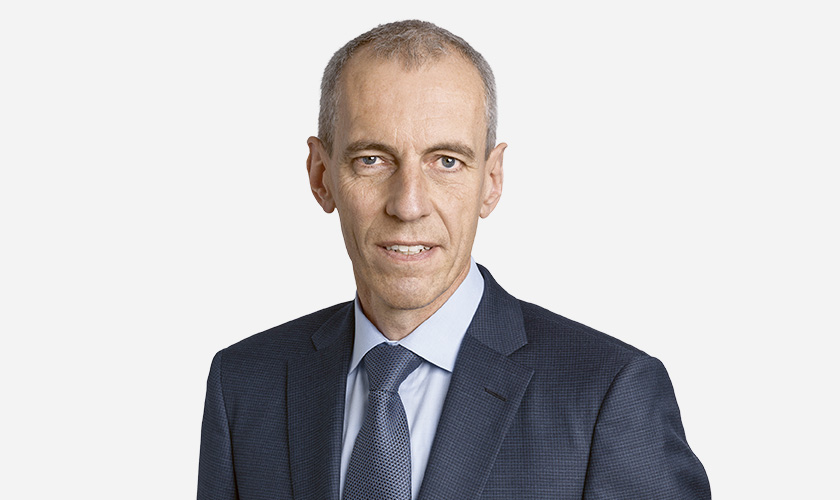Our resilient balance sheet
protects our franchise and
makes us a reliable partner
for our clients.
The Group’s capital position remains very strong with a Group SST ratio of 232% as of 1 January 2020, compared with the 220% target. This is supported by our diversified business model and disciplined risk-taking.
Financial strength
Swiss Re maintained a strong capital position during 2019 despite significant loss events. The Group’s capital position remains very strong with a Group Swiss Solvency Test (SST) ratio of 232% as of 1 January 2020, which remains above Swiss Re’s target capitalisation of 220%. Rating agencies A.M. Best, Moody’s and Standard & Poor’s (S&P) rated Swiss Re’s financial strength ‘superior’, ‘excellent’ and ‘very strong’, respectively. This capital strength enables Swiss Re to support its clients while continuing to return capital to shareholders.

The strength of our business model allows us to continue to offer an attractive dividend bolstered by a public share buyback programme.
John R. Dacey
Group Chief Financial Officer
Swiss Re’s overarching target is to maintain a very strong capital position that operates efficiently within constraints imposed by regulators and requirements from rating agencies, while giving the company maximum financial flexibility. Swiss Re’s capital allocation decisions are steered to make capital and liquidity fungible to the Group wherever possible, while complying with local regulations and client needs. Cash dividends paid by our Business Units to the Group’s parent holding company, Swiss Re Ltd, have amounted to USD 24.2 billion since 2013.
Based on the Group’s capital strength, the Board of Directors proposes a 2019 regular dividend of CHF 5.90 per share. In addition, the Board of Directors proposes a further public share buyback programme at the discretion of the Board of Directors and subject to obtaining all necessary legal and regulatory approvals.
Liquidity
Our core insurance and reinsurance operations generate liquidity primarily through premium income. Our exposure to liquidity risk stems mainly from two sources: the need to cover potential extreme loss events and regulatory constraints that limit the flow of funds within the Group.
The amount of liquidity held is largely determined by internal liquidity stress tests, which estimate the potential funding requirements stemming from extreme loss events. Based on these internal liquidity stress tests, we estimate that Swiss Reinsurance Company Ltd, the most important legal entity of the Group from a liquidity perspective, currently holds significant surplus liquidity.
Swiss Re also provides FINMA, its principal regulator, with a yearly report on its liquidity position, in accordance with FINMA Circular 13/5, “Liquidity — Insurers”.
Risk Management
Group Risk Management is key to the controlled risk-taking that underpins Swiss Re’s financial strength. Risk Management is mandated to ensure that the Group and its legal entities have the necessary expertise, frameworks and infrastructure to support good risk-taking. In addition, it monitors and ensures adherence to applicable frameworks and also performs reserving and reporting activities.

Swiss Re’s leadership in sustainability reflects our strong commitment to steer our business towards a low-carbon future.
Patrick Raaflaub
Group Chief Risk Officer
Risk Management is embedded throughout Swiss Re’s business. The Group has dedicated Chief Risk Officers and risk teams for all major legal entities and regions. These are closely aligned to Swiss Re’s business structure, in order to ensure effective risk oversight, but remain part of the Risk Management function under the Group CRO, thus ensuring their independence as well as a consistent Group-wide approach to overseeing and controlling risks. They are supported in this by central risk teams that provide specialised risk expertise and oversight.
The Group’s risk-taking is steered by Swiss Re’s Risk Appetite Framework, which consists of two interlinked components: risk appetite and risk tolerance. The risk appetite statement facilitates discussions about where and how Swiss Re should deploy its capital, liquidity and other resources under a risk/return view. The risk tolerance sets clear boundaries to risk-taking.
Swiss Re’s proprietary integrated risk model provides a meaningful assessment of the risks to which the Group is exposed and represents an important tool for managing our business. It determines the capital requirements for internal purposes and forms the basis for regulatory reporting under the SST and under Solvency II for our legal entities in the European Economic Area (EEA) and the United Kingdom.
Swiss Re continuously reviews and updates its internal model and parameters to reflect the Group’s experiences and changes in the risk environment and current best practice.
Swiss Re’s risk profile
In SST 2020, Swiss Re’s overall risk increases to USD 21.3 billion (compared to USD 19.7 billion in SST 2019), driven by higher insurance risk mainly reflecting business growth and lower interest rates impact. Financial market and credit risk increase only marginally.
The increase in property and casualty risk mainly reflects growth in property business, translating into higher exposure to key natural catastrophe scenarios.
Higher life and health risk mainly reflects the impact of lower interest rates and business growth.
Financial market risk increases slightly, mainly due to repositioning of the credit portfolio, resulting in higher credit spread risk. The slight increase in credit risk is driven mainly by higher credit and surety underwriting risk.